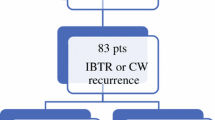Abstract
Background: The purpose of this study was to examine the rate of axillary failure in patients with primary breast cancer treated without axillary dissection or radiation and to determine what factors may be associated with axillary failure.
Methods: We studied 112 patients with invasive breast cancer treated for primary disease with breast-conserving surgery without axillary dissection or radiation to the breast or axilla, accrued between 1977 and 1986. Data for these patients were prospectively gathered for a research database and reviewed retrospectively to determine axillary failure. The effects of age, tumor size, estrogen receptor (ER) status, progesterone receptor (PgR) status, histologic grade, nuclear grade, and tumor emboli on time to axillary failure were examined.
Results: The median follow-up was 9.6 years. There were 26 axillary recurrences, resulting in a 10-year actuarial nodal control rate of 72%. Patients with nodal failure proceeded to axillary dissection with minimal morbidity. In both univariate and multivariate analyses, only tumor size was significantly associated with axillary failure (p=0.04 andp=0.06, respectively).
Conclusions: This study demonstrates a significant effect of tumor size on axillary failure and a reasonable rate of local control in small tumors. Further research should examine the utility of axillary dissection in women with small breast cancers.
Similar content being viewed by others
References
Balch C, Singletary S, Bland K. Clinical decision-making in early breast cancer.Ann Surg 1993;217:207–25.
Fisher B, Redmond C, Poisson R, et al. Five-year results of a randomized clinical trial comparing total mastectomy and segmental mastectomy with or without radiation in the treatment of breast cancer.N Engl J Med 1985;312:665–73.
Cabanes P, Salmon R, Vilcoq J, et al. Value of axillary dissection in addition to lumpectomy and radiotherapy in early breast cancer.Lancet 1992;339:1245–8.
Sacks NP, Baum M. Primary management of carcinoma of the breast.Lancet 1993;342:1402–8.
Fisher B, Redmond C, Fisher ER, et al. Ten year results of a randomized clinical trial comparing radical mastectomy and total mastectomy with or without radiation.N Engl J Med 1985;312:674–81.
Cancer Research Campaign Working Party. CRC (Kings/Cambridge) trial for early breast cancer: a detailed update and the tenth year.Lancet 1980;2:55–60.
Sacre RA. Clinical evaluation of axillary lymph nodes compared to surgical and pathological findings.Eur J Surg Oncol 1986;12:169–73.
Wallace IW, Champion HR. Axillary nodes in breast cancer.Lancet 1972;1:217–18.
Muss H. The role of chemotherapy and adjuvant therapy in the management of breast cancer in older women.Cancer 1994;74(suppl):2165–71.
Martin L, le Pechoux C, Calitchi F, et al. Management of breast cancer in the elderly.Eur J Cancer 1994;30A:590–6.
Maunsell E, Brisson J, Deschenes L. Arm problems and psychological distress after surgery for breast cancer.Can J Surg 1993;36:315–20.
Werner R, McCormick B, Petrek J, et al. Arm edema in conservatively managed breast cancer: obesity is a major predictive factor.Radiology 1991;180:177–84.
Hladiuk M, Huchcroft S, Temple W, Schnurr B. Arm function after axillary dissection for breast cancer: a pilot study to provide parameter estimates.J Surg Oncol 1992;50:47–52.
Halverson K, Taylor M, Perez C, et al. Regional nodal management and patterns of failure following conservative surgery and radiation therapy for stage I and II breast cancer.Int J Radiat Oncol Biol Phys 1993;26:593–9.
Cady B, Stone M, Wayne J. New therapeutic possibilities in primary invasive breast cancer.Ann Surg 1993:218:338–49.
Clark R, Wilkinson R, Miceli P, MacDonald W. Breast cancer experiences with conservation therapy.Am J Clin Oncol 1987;10:461–8.
Baum M, Coyle P. The clinical behaviour of untreated axillary nodes following simple mastectomy for early carcinoma of the breast.Clin Oncol 1980;6:221–4.
Sawka CA, Pritchard KI, Lickley HLA. The Henrietta Banting Breast Centre database: a model for clinical research utilizing a hospital-based inception cohort.J Clin Epidemiol 1995;48:779–86.
McCready D, Hanna W, Kahn H, et al. What factors are important for local breast cancer recurrence following lumpectomy alone?Can J Surg 1993;36:380.
Prentice RL, Marek P. A qualitative discrepancy between censored data and rank tests.Biometrics 1979;35:861–7.
Mobbs BG, Johnson IE. Use of an enzyme immunoassay (EIA) for quantitation of cytosolic and nuclear estrogen receptor, and correlation with progesterone receptor in human breast cancer.J Steroid Biochem 1987;28:653–62.
Early Breast Cancer Trialists' Collaborative Group. Effects of adjuvant tamoxifen and of cytotoxic therapy on mortality in early cancer.N Engl J Med 1988;319:1681–92.
Wolmark N, Fisher B. Surgery in the primary treatment of breast cancer.Breast Cancer Res Treat 1982;1:339–48.
Miller B, Feuer E, Hankey B. Recent incidence trends for breast cancer in women and the relevance of early detection: an update.CA Cancer J Clin 1993;43:27–41.
Fisher B, Anderson S, Fisher E, et al. Significance of ipsilateral breast tumour recurrence after lumpectomy.Lancet 1991;338:327–31.
Ravdin PM, De Laurentis M, Vendely T, Clark G. Prediction of axillary lymph node status in breast cancer patients by use of prognostic indicators.J Natl Cancer Inst 1994;86:1171–5.
Author information
Authors and Affiliations
Rights and permissions
About this article
Cite this article
Baxter, N., McCready, D., Chapman, JA. et al. Clinical behavior of untreated axillary nodes after local treatment for primary breast cancer. Annals of Surgical Oncology 3, 235–240 (1996). https://doi.org/10.1007/BF02306277
Received:
Accepted:
Issue Date:
DOI: https://doi.org/10.1007/BF02306277




